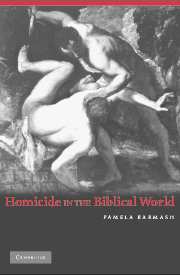Book contents
- Frontmatter
- Contents
- Abbreviations
- Acknowledgments
- Introduction
- CHAPTER ONE A First Case: The Story of Cain and Abel
- CHAPTER TWO Blood Feud and State Control
- CHAPTER THREE The Development of Places of Refuge in the Bible
- CHAPTER FOUR Pollution and Homicide
- CHAPTER FIVE Typologies of Homicide
- CHAPTER SIX Lex Talionis
- CHAPTER SEVEN Interterritorial Law: The Homicide of a Foreign Citizen
- Conclusion
- Appendix: Cuneiform Sources on Homicide
- Bibliography
- General Index
- Index of Citations
CHAPTER THREE - The Development of Places of Refuge in the Bible
Published online by Cambridge University Press: 17 November 2009
- Frontmatter
- Contents
- Abbreviations
- Acknowledgments
- Introduction
- CHAPTER ONE A First Case: The Story of Cain and Abel
- CHAPTER TWO Blood Feud and State Control
- CHAPTER THREE The Development of Places of Refuge in the Bible
- CHAPTER FOUR Pollution and Homicide
- CHAPTER FIVE Typologies of Homicide
- CHAPTER SIX Lex Talionis
- CHAPTER SEVEN Interterritorial Law: The Homicide of a Foreign Citizen
- Conclusion
- Appendix: Cuneiform Sources on Homicide
- Bibliography
- General Index
- Index of Citations
Summary
EACH LEGAL corpus of the Pentateuch makes reference to refuges for a killer. These sources differ on certain fundamental characteristics of such refuges, raising the question of whether these differences reflect historical development in the system of asylum.
Julius Wellhausen, whose work represents the capstone of nineteenth-century critical scholarship, argues that there were major changes in the adjudication of homicide. In the earliest period, he proposes, sanctuaries were places of asylum: A fugitive would enter a sanctuary and take hold of the horns of the altar, obtaining sanctuary from an avenger in hot pursuit, according to the evidence of Exod 21:13–14 and 1 Kgs 2:28. Then, during the Deuteronomic reform in the seventh century b.c.e., in order to prevent the loss of the institution of asylum when local altars were abolished, Josiah appointed special cities of refuge (Deut 19:1–13). Wellhausen concludes that the Priestly legislator affirmed this arrangement and specified six cities of refuge, three on each side of the Jordan (Num 35:9–34; Josh 20:1–9). Since four of these cities were cultic sites known from other biblical texts and the cities of refuge were also Levitical cities, it seemed obvious to Wellhausen that the special status of the cities of refuge was linked to the presence of an ancient altar. He recognized, to be sure, that not every sacred site was a city of refuge. Some that became infamous as sites of pagan worship, such as Bethel, Dan, Gilgal, and Beersheba, were intentionally omitted.
- Type
- Chapter
- Information
- Homicide in the Biblical World , pp. 71 - 93Publisher: Cambridge University PressPrint publication year: 2004



